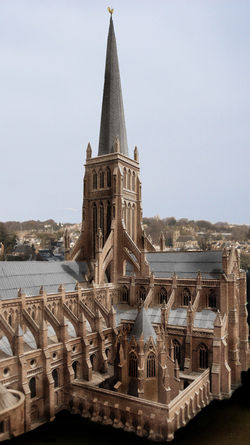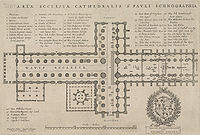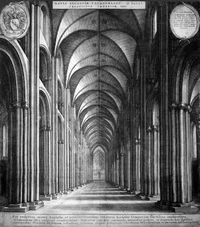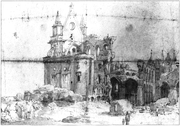Old St Paul's Cathedral
| Old St Paul's Cathedral | |
 |
|
| History | |
|---|---|
| Authorising papal bull | None |
| Significant events | Cathedral and chanonry destroyed by fire—1087, 1666 |
| Significant associated people | John of Gaunt John Beauchamp John Donne |
| Administration | |
| Deanery | City of London Paddington St Margaret St Marylebone |
| Diocese | Diocese of London (Londinium) |
| Clergy | |
| Bishop(s) | William Warham Edmund Bonner Edwin Sandys William Laud |
Old St. Paul's is a name used to refer to the Gothic cathedral in the City of London built between 1087 and 1314.[1] At its peak, the cathedral was the third longest church in Europe, had one of the tallest spires and some of the finest European stained glass.
The cathedral was the fourth church on the site at Ludgate Hill dedicated to St Paul, and was begun by the Normans following a devastating fire in 1087 which destroyed much of the city. Work took over 200 years, and construction was delayed in another fire in 1135. The church was consecrated in 1240 and enlarged again in 1256 and the early 1300s. Built to house the remains of St Erkenwald, during the Middle Ages, it was also the site of pilgrimage.[2]
In addition to its purpose as the mother church of the Diocese of London, the building developed a reputation as a hub of the City of London, with the nave aisle "Paul's walk" known as a centre for business and the London grapevine. Following the Reformation, the open air pulpit in the churchyard, St Paul's Cross, became the stage for radical evangelical preaching and Protestant bookselling.
Already severely in decline by the 17th century, the cathedral was destroyed in the Great Fire of London of 1666, and the current domed St. Paul's Cathedral — in an English Baroque style — was subsequently erected on the site by Sir Christopher Wren.[3]
Contents |
Construction


The cathedral was the fourth church on the site at Ludgate Hill dedicated to St Paul, and housing the relics of St Erkenwald.[4] Following a devastating fire in 1087 (detailed in the Anglo-Saxon Chronicle) which destroyed much of the city and the cathedral, King William bequeathed the stone from the destroyed Palatine Tower on the River Fleet towards the construction of a new, Romanesque Norman cathedral.[5]
Bishop Maurice began the building, although it was primarily under his successor, Richard de Beaumis, that work fully commenced. Beaumis was assisted by King Henry I, who gave the bishop stone and commanded that all material brought up the River Fleet for the cathedral should be free from toll. He also gave Beaumis tithes on fish caught within the cathedral neighbourhood and venison taken in the County of Essex to fund the cathedral. Beaumis also gave a site for the original foundation of St. Paul's School.[6]
Following Henry I's death, a civil war known as "The Anarchy" broke out. Henry of Blois, Bishop of Winchester, was appointed to administer the affairs of St. Paul's. Almost immediately, he had to deal with the aftermath of a fire which broke out at London Bridge in 1135. The fire spread over much of the city, damaging the cathedral and delaying its construction.[7] During this period, the style of the building transitioned from heavy Romanesque into Early English Gothic. Although the base Norman columns were left alone, Lancet pointed arches were placed over them in the triforium and some heavy columns were substitued by clustered pillars.[8] The steeple was erected in 1221 and the cathedral was rededicated by Bishop Roger Niger in 1240.[9]
Following a succession of tempests, in 1255 Bishop Fulk Basset appealed for funds to the repair of the damaged roof. The roof was once more rebuilt in wood, which was ultimately to doom the building. At this time, the east end of the cathedral church was lengthened, enclosing the parish church of St Faith, which was now brought within the cathedral.[10][11] The eastward addition was always referred to as "The New Work".[12][13]
Following complaints from the dispossessed parishioners of St Faith's, the east end of the west crypt was allotted to them as their parish church. The congregation were also allowed to keep a detached tower with a peal of bells east of the church which had historically been used to peal the summons to the Cheapside Folkmote. The parish later moved to the Jesus chapel during the reign of Edward VI and was merged with St Augustine Watling Street following the 1666 fire.[14]
This "New Work" was completed in 1314, although the additions had been consecrated in 1300. St Paul's was now the third-longest church in Europe.[15] Excavations in 1878 by Francis Penrose showed it was 586 feet (179 m) long (excluding the porch later added by Inigo Jones) and 100 feet (30 m) wide (290 feet across the transepts and crossing). By way of comparison, the current cathedral is 574 feet (175 m) in length including the portico, and 246 feet (75 m) across the transepts.
The cathedral had one of Europe's tallest spires, the height of which is traditionally given as 489 feet (149 m). The King's Surveyor, Christopher Wren (1632-1723), judged that an overestimate and gave 460 feet (140 m).[16] Canon William Benham (rector of St Edmund, King and Martyr) notes that the cathedral probably "resembled in general outline that of Salisbury, but it was a hundred feet longer, and the spire was sixty or eighty feet higher. The tower was open internally as far as the base of the spire, and was probably more beautiful both inside and out than that of any other English cathedral."[17]
According to the architectural historian John Harvey, the octagonal chapter house (built circa 1332 by William Ramsey), was the earliest example of Perpendicular Gothic.[18] The foundations of the chapter house were recently made visible in the redeveloped south churchyard of the new cathedral.[19]
Interior

The finished cathedral of the Middle Ages was renowned for its interior beauty. Canon William Benham wrote in 1902: "It had not a rival in England, perhaps one might say in Europe."[20] The nave's immense length was particularly notable, with a Norman triforium and vaulted ceiling. The length earned it the nickname "Paul's walk". The cathedral's stained glass was reputed to be the best in the country, and the east-end Rose window was particularly exquisite. The poet Geoffrey Chaucer uses the windows as a metaphor in "The Miller's Tale" from The Canterbury Tales, in the knowledge that other Londoners would understand the comparison:[21]
| “ | His rode was red, his eyen grey as goose, With Paule's windows carven on his shoes |
” |

Monarchs and other dignitories were often in attendance at the cathedral, and the court occasionally held session there.[22] The building was also the scene of several incidents of mediaeval intrigue. In 1191, whilst King Richard I was in Palestine, his brother John summoned a council of bishops to St Paul's to denounce William de Longchamp, Bishop of Ely, (to whom Richard had entrusted the affairs of government) for treason.[23] Later that year, William Fitz Osbern gave a fiery speech against the oppression of the poor at Paul's Cross and incited a riot in which the cathedral was invaded. The riot was only halted by an appeal for calm by Hubert Walter, Archbishop of Canterbury. Osbern baracaded himself in nearby St Mary-le-Bow and was later executed, after which Paul's Cross was silent for many years.[24] Arthur, Prince of Wales, son of Henry VII, married Catharine of Aragon in St. Paul's on November 14th, 1501. Chroniclers are profuse in their descriptions of the decorations of the cathedral and city on that occasion. Arthur died five months later, at the age of 15, and the marriage was later to prove contentious during the subsequent reign of his brother, Henry VIII.[25]
Several kings of the Middle Ages lay in state in St Paul's before their funerals at Westminster Abbey, including Richard II, Henry VI and Henry VII.[26] In the case of Richard II, the display of his body in such a public place was to counter rumours that he was not deceased.[27] The walls were lined with the tombs of mediaeval bishops and nobility. In addition to the shrine of Erkenwald, two Anglo-Saxon kings were buried inside; Sebbi, King of the East Saxons, and Ethelred the Unready.[28] A number of figures such as John of Gaunt, 1st Duke of Lancaster and John Beauchamp, 3rd Baron Beauchamp de Somerset had particularly large monuments constructed within the cathedral, and the building was also to later contain the tombs of the Crown minister Nicholas Bacon and the poet and clergyman John Donne (who was dean of the cathedral between 1621 until his death in 1631).[29] Donne's monument survived the 1666 fire, and is on display in the present building.[30]
Paul's Walk

The first historical reference to the nave, "Paul's walk", being used as a marketplace and general meeting area is recorded during the 1381–1404 tenure of Bishop Braybrooke.[31] The bishop issued an open letter decrying the use of the building for selling "wares, as if it were a public market" and "others ... by the instigation of the Devil [using] stones and arrows to bring down the birds, jackdaws and pigeons which nestle in the walls and crevises of the building. Others play at ball ... breaking the beautiful and costly painted windows to the amazement of spectators."[32] His decree goes on to threaten perpetrators with excommunication.[33]
By the 15th century, the cathedral had become the centre of the London grapevine.[34] "News mongers", as they were called, gathered there to pass on the latest news and gossip.[35] Those who visited the cathedral to keep up with the news were known as "Paul's walkers".
According to Francis Osborne (1593–1656):
It was the fashion of those times ... for the principal gentry, lords, courtiers, and men of all professions not merely mechanic, to meet in Paul's Church by eleven and walk in the middle aisle till twelve, and after dinner from three to six, during which times some discoursed on business, others of news. Now in regard of the universal there happened little that did not first or last arrive here ... And those news-mongers, as they called them, did not only take the boldness to weigh the public but most intrinsic actions of the state, which some courtier or other did betray to this society.[36]
St Paul's became the place to go to hear the latest news of current affairs, war, religion, parliament and the court. In his play Englishmen for my Money, William Haughton (d. 1605) described Paul's walk as a kind of "open house" filled with a "great store of company that do nothing but go up and down, and go up and down, and make a grumbling together".[37] Infested with beggars and thieves, Paul's walk was also a place to pick up gossip, topical jokes, and even prostitutes.[38][39] John Earle (1601–1665), in his Microcosmographie (1628), called Paul's walk "the land's epitome ... the lesser isle of Great Britain ... the whole world's map ... nothing like Babel".[40]
Decline

By the 16th century the building was decaying. Under Henry VIII and Edward VI, the Dissolution of the Monasteries and Chantries Acts led to the destruction of interior ornamentation and the cloisters, charnels, crypts, chapels, shrines, chantries and other buildings in the churchyard. Many of these former religious sites in St Paul's Churchyard, having been seized by the crown, were sold as shops and rental properties, especially to printers and booksellers, such as Thomas Adams, who were often evangelical Protestants. Buildings that were razed often supplied ready-dressed building material for construction projects, such as the Lord Protector's city palace, Somerset House.[15]
Crowds were drawn to the northeast corner of the Churchyard, St Paul's Cross, where open-air preaching took place. It was there in the Cross Yard in 1549 that radical Protestant preachers incited a mob to destroy many of the cathedral's interior decorations. In 1554, in an attempt to end inappropriate practices taking place in the nave, the Lord Mayor decreed that the selling of horses, beer and "other gross wares" was "to the great dishonour and displeasure of Almighty God, and the great grief also and offence of all good and well-disposed persons" and that the church should return to its original purpose as a religious building.[41]
In 1561 the spire was destroyed by lightning, which caught fire and crashed through the nave roof. The subsequent conflagration was hot enough to melt the cathedral's bells and the lead covering the wooden spire "poured down like lava upon the roof", destroying it.[42][43] This event was taken by both Protestants and Catholics as a sign of God's displeasure at the other faction's actions. Queen Elizabeth contributed towards the cost of repairs, although the spire was never rebuilt.[44] The repair work on the nave roof was sub-standard, however, and only fifty years after the rebuilding was in a dangerous condition.[45]

Concerned at the decaying state of the building, King James I appointed England's first classical architect, Inigo Jones, to restore the building. The poet Henry Farley records the king comparing himself to the building at the commencement of the work in 1621: "I have had more sweeping, brushing and cleaning than in forty years before. My workmen looke like him they call Muldsacke after sweeping of a chimney."[46] In addition to cleaning and rebuilding parts of the gothic structure, Jones added a classical-style portico to the cathedral's west front in the 1630s, which William Benham notes was "altogether incongruous with the old building...It was no doubt fortunate that Inigo Jones confined his work at St. Paul's to some very poor additions to the transepts, and to a portico, very magnificent in its way, at the west end."[47]
Work stopped during the English Civil War, and there was much defacement and mistreatment of the building by Parliamentarian forces during which old documents and charters were dispersed and destroyed, and the nave used as a stable for cavalry horses.[48] Much of the detailed information historians have of the cathedral is taken from William Dugdale's 1658 History of St Pauls Cathedral, written hastily during The Protectorate for fear that "one of the most eminent Sturctures of that kinde in the Christian World" might be destroyed.[49]
Indeed, a persistant rumour of the time suggested that Cromwell had considered giving the building to London's returning Jewish community to become a synagogue.[50] Dugdale embarked on his project due to discovering hampers full of decaying 14th and 15th century documents from the Cathedral's early archives.[51] In his book's dedicatory epistle, he wrote:
...so great was your foresight of what we have since by wofull experience seen and felt, and specially in the Church, (through the Presbyterian contagion, which then began violently to breake out) that you often and earnestly incited me to a speedy view of what Monuments I could, especially in the principall Churches of this Realme; to the end, that by Inke and paper, the Shadows of them, with their Inscriptions might be preserved for posteritie, forasmuch as the things themselves were so neer unto ruine.[49]
Dugdale's book is also the source for many of the surviving engravings of the building, created by Bohemian etcher Wenceslaus Hollar. In July 2010, an original sketch for Hollar's engravings was rediscovered when it was submitted to Sotheby's auction house.[51]
The Great Fire



Restoration of old St Paul's finally began in the 1660s but only had time to be sheathed in wooden scaffolding before being completely gutted in the Great Fire of London of 1666. The fire, aided by the scaffolding, destroyed the roof and much of the stonework along with masses of stocks and personal belongings that had been placed there for safety. Samuel Pepys recalls the building in flames in his diary:[52]
| “ | "Up by five o'clock, and blessed be God! find all well, and by water to Paul's Wharf. Walked thence and saw all the town burned, and a miserable sight of Paul's Church, with all the roof fallen, and the body of the choir fallen into St. Faith's; Paul's School also, Ludgate, and Fleet Street. | ” |
John Evelyn's account paints a similar picture of destruction:
September 3rd - I went and saw the whole south part of the City burning from Cheapeside to the Thames, and ... was now taking hold of St. Paule's Church, to which the scaffolds contributed exceedingly.
September 7th - I went this morning on foote from White-hall as far as London Bridge, thro' the late Fleete-streete, Ludgate Hill, by St. Paules ... At my returne I was infinitely concern'd to find that goodly Church St. Paules now a sad ruine, and that beautifull portico ... now rent in pieces, flakes of vast stone split asunder, and nothing now remaining intire but the inscription in the architrave, shewing by whom it was built, which had not one letter of it defac'd. It was astonishing to see what immense stones the heate had in a manner calcin'd, so that all the ornaments, columns, freezes, capitals, and projectures of massie Portland-stone flew off, even to the very roofe, where a sheet of lead covering a great space (no less than six akers by measure) was totally mealted; the ruines of the vaulted roofe falling broke into St. Faith's, which being fill'd with the magazines of bookes belonging to the Stationers, and carried thither for safety, they were all consum'd, burning for a weeke following. It is also observable that the lead over the altar at the East end was untouch'd, and among the divers monuments, the body of one Bishop remain'd intire. Thus lay in ashes that most venerable Church, one of the most antient pieces of early piety in the Christian world.[53]
Temporary repairs were made to the building, but while it might have been salvageable, albeit with almost complete reconstruction, a decision was taken to build a new cathedral in a modern style instead, a step which had been contemplated even before the fire. Sir Christopher Wren, the Surveyor to the King's Works, had already declared that it was impossible to restore the old building, and in the following April, the Dean William Sancroft wrote to him that he had been right in his judgement: "Our work at the west end," he wrote, "has fallen about our ears." Two pillars had collapsed, and the rest was so unsafe that men were afraid to go near, even to pull it down. He added, "You are so absolutely necessary to us that we can do nothing, resolve on nothing without you."[54]
Following this declaration by the Dean, demolition of the remains of the old cathedral began. Wren initially used the then-new technique of using gunpowder to bring down the surviving stone walls.[55] Like many experimental techniques, the use of gunpowder was not easy to control and nearby residents complained about noise and damage. Eventually, Wren resorted to using a battering ram instead. Building work on the new cathedral began in June 1675.[56]
References
- ↑ Benham, 3-7
- ↑ Milman, 22
- ↑ Hibbert,C; Weinreb,D; Keay,J, The London Encyclopaedia. London: Pan Macmillan, 1983 (rev 1993,2008) ISBN 978-1-4050-4924-5
- ↑ Milman, 22
- ↑ Milman, 21
- ↑ Benham, 4
- ↑ Benham, 4
- ↑ Benham, 5
- ↑ Benham, 5
- ↑ Hibbert,C; Weinreb,D; Keay,J, The London Encyclopaedia. London: Pan Macmillan, 1983 (rev 1993,2008) ISBN 978-1-4050-4924-5
- ↑ Harbens, H.A, A dictionary of London: being notes topographical and historical relating to the streets and principal buildings in the City of London. London: Herbert Jenkins Ltd, 1918
- ↑ Benham, 6
- ↑ Huelin, G, Vanished Churches of the City of London, London: Guildhall Library Publishing, 1996 ISBN 0900422424
- ↑ Reynolds, H, (1922) The Churches of the City of London. London: Bodley Head, 194.
- ↑ 15.0 15.1 1086 cathedral, St. Paul's official website, accessed 7 September 2010.
- ↑ Benham, 8
- ↑ Benham, 8
- ↑ Harvey, 105
- ↑ Peterkin, Tom (4 June 2008). "St Paul's Cathedral opens new South Churchyard". The Daily Telegraph (London). http://www.telegraph.co.uk/news/2074873/St-Pauls-Cathedral-opens-new-South-Churchyard.html. Retrieved 2009-11-18.
- ↑ Benham, 8
- ↑ Chaucer, Geoffrey. “The Miller's Tale”, The Canterbury Tales at Project Gutenberg
- ↑ Benham, 36
- ↑ Milman, 38
- ↑ Benham, 28
- ↑ Benham, 36
- ↑ Benham, 36
- ↑ Milman, 81
- ↑ Benham, 17
- ↑ Benham, 15-18
- ↑ John Donne at poetsgraves.co.uk, Retrieved 6 September 2010
- ↑ Benham, 16
- ↑ Milman, 83-84
- ↑ Milman, 84
- ↑ Benham, 14
- ↑ Notestein, 31
- ↑ Francis Osborne, Works (1689, 9th ed.), 449–451, quoted in Thomson, Chamberlain Letters, 1
- ↑ Quoted in Ostovich, 61
- ↑ Notestein, 30–32
- ↑ Ostovich, 108n, 215n.
- ↑ Quoted in Notestein, 31n
- ↑ Quoted in Benham, 47
- ↑ Reynolds, H., The Churches of the City of London, London:Bodley Head, 1922
- ↑ Benham, 50
- ↑ St. Paul's Cathedral timeline, URL accessed 28 January 2007.
- ↑ Benham, 64
- ↑ Quoted in Benham, 68. A muld was a tribute or an offering.
- ↑ Benham, 67-68
- ↑ Kelly, 50
- ↑ 49.0 49.1 Dugdale, William, The History of St Pauls Cathedral in London from its Foundation until these Times. London: T. Warren, 1658
- ↑ Benham, 68
- ↑ 51.0 51.1 "Detailed Drawing of London's Old St. Paul's Cathedral, to Be Sold at Sotheby's", www.artdaily.com, Retrieved 5 September 2010
- ↑ Pepys, Samuel (1666). Diary at Project Gutenberg
- ↑ Quoted in Benham, 74-75
- ↑ Benham, 74-75
- ↑ Benham, 76
- ↑ 1668 — The Demolition, St. Paul's official website, accessed 7 September 2010.
- Bibliography
- Benham, William (1902). Old St. Paul's Cathedral. London: Seeley & Co at Project Gutenberg
- Cook, George Henry (1955). Old St. Paul's Cathedral: a lost glory of medieaval London. London: Phoenix House.
- Dugdale, William, The History of St Pauls Cathedral in London from its Foundation until these Times. London: T. Warren, 1658.
- Harvey, John (1978). The Perpendicular Style. London: Batsford. ISBN 9780713416107.
- Kelly, Susan (2004). Charters of St Paul's, London. Oxford: Oxford University Press. ISBN 9780197262993.
- Lang, Jane (1956). Rebuilding St. Paul's after the great fire of London. Oxford: Oxford University Press.
- Milman, Henry Hart (1868). Annals of St. Paul's Cathedral. London: Murray.
- Notestein, Wallace (1956). Four Worthies: John Chamberlain, Lady Anne Clifford, John Taylor, Oliver Heywood. London: Jonathan Cape. OCLC 1562848.
- Ostovich, Helen (ed.) (2001). Every Man Out of His Humour by Ben Jonson. Manchester: Manchester University Press. ISBN 0719015588.
- Oggins, Robin S. (1996). Cathedrals. New York: Sterling Publishing. ISBN 156799346X.
External links
- Official website, with history of Old St. Paul's
|
|||||